Use ultraviolet filters on lights
-
Overall effectiveness category Unknown effectiveness (limited evidence)
-
Number of studies: 1
View assessment score
Hide assessment score
How is the evidence assessed?
-
Effectiveness
45% -
Certainty
22% -
Harms
0%
Study locations
Supporting evidence from individual studies
A replicated, randomized, controlled study in 2014 at five hedges in Devon, UK (Mathews et al 2015) found that hedges lit with ultraviolet (UV) filtered lights had higher activity for one of two bat species than at hedges lit with unfiltered lights or unlit hedges. Soprano pipistrelle Pipistrellus pygmaeus activity was higher at hedges lit with UV filtered lights (average 5 bat passes/night) than at hedges lit with unfiltered lights (3 bat passes/night) or at unlit hedges (4 bat passes/night). Common pipistrelle Pipistrellus pipistrellus activity did not differ significantly between any of the light treatments (data not reported). At each of five hedges, two lights (8W LED flood lamps with additional UV bulbs) were set up 15 m apart and 5 m high. Filtered lights were covered with UV film filters to reduce UV emissions by 40%. Three treatments (UV filtered lights, unfiltered lights, unlit/control) were carried out at each pair of lights in a random order for three nights each between July and October 2014. Two additional unlit locations were also surveyed at each site. During each night, bat activity was recorded using bat detectors placed at the treatment site and at the unlit locations for 3 h from sunset.
Study and other actions tested
Where has this evidence come from?
List of journals searched by synopsis
All the journals searched for all synopses
This Action forms part of the Action Synopsis:
Bat Conservation
Bat Conservation - Published 2021
Update 2020





)_2023.JPG)














